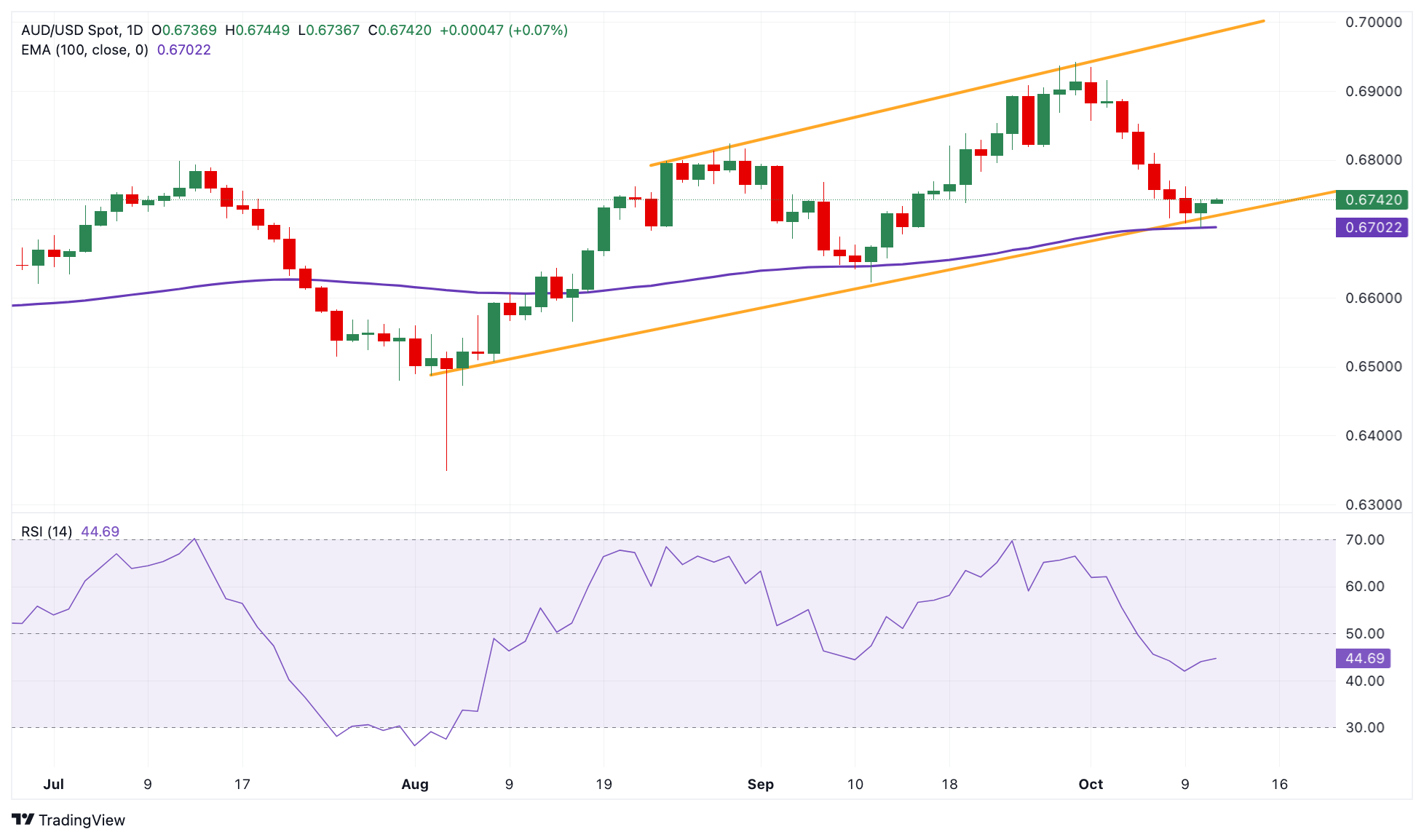- The Australian Dollar is trading in positive territory for the second day in a row in the Asian session on Friday.
- Lowering expectations of deeper Fed rate cuts supports the USD and weighs on the pair.
- Investors are preparing for US PPI data, due out on Friday.
The Australian Dollar (AUD) gains ground on Friday. However, lower chances of aggressive interest rate cuts by the US Federal Reserve (Fed) following higher-than-expected inflation data could boost the US Dollar (USD) and limit the rise of the pair.
In the absence of top-tier economic data releases from Australia on Friday, USD price dynamics will be the main driver for AUD/USD. Investors will be watching the release of the US Producer Price Index (PPI), which will be released on Friday. The headline PPI is expected to show a 1.6% YoY increase in September, while the core PPI is estimated to see a 2.7% YoY increase over the same period. If reports show a softer than expected result, this could weigh on the USD and act as a tailwind for AUD/USD. Additionally, the preliminary Michigan Consumer Sentiment Index will be released later in the day.
Daily Market Summary: Australian Dollar Extends Recovery Ahead of Other US Inflation Data
- Minutes from the RBA’s September meeting showed council members ignored the warning that there would be no rate cuts in the near future. The Australian central bank wants to keep its options open, watching to see if the economy starts to rebound in the second half of the year.
- The US Consumer Price Index (CPI) rose 2.4% year-on-year in September, compared with 2.5% in August, above the consensus of 2.3%, the US Department of Labor Statistics showed on Thursday. .US Core CPI, excluding food and energy, rose 3.3% year-on-year in September, above the forecast and the previous reading of 3.2%.
- Initial US jobless claims for the week ending October 4 rose to 258,000, from 225,000 the previous week. The figure was above the initial consensus of 230,000.
- New York Fed President John Williams said Thursday he expects more rate cuts ahead as inflation pressures continue to moderate and the economy remains strong.
- Chicago Fed President Austan Goolsbee signaled that he sees a series of rate cuts in the next year to year and a half, noting that inflation is now near the Fed’s 2% target and the economy is near full employment.
- Atlanta Fed President Raphael Bostic is open to the idea of skipping a rate cut in November if economic data has not yet aligned with the Fed’s target numbers in time.
Technical Analysis: Australian Dollar maintains positive long-term stance
The Australian Dollar trades stronger on the day. According to the daily chart, the AUD/USD pair maintains the bullish vibe as the price is well supported above the lower boundary of the ascending trend channel and the key 100-day exponential moving average (EMA). However, a further decline cannot be ruled out as the 14-day Relative Strength Index (RSI) is below the midline near 44.70.
The first barrier to the upside emerges near the September 6 high at 0.6767. Extended gains could pave the way towards 0.6823, the August 29 high. Any follow-up buying above the mentioned level could see a rally towards 0.6942, the September 30 high.
On the other hand, the key support level is seen at 0.6700, representing the lower boundary of the trend channel, the 100-day EMA, and the psychological level. A break of this level could expose 0.6622, the 9/11 low.
The Australian Dollar FAQs
One of the most important factors for the Australian Dollar (AUD) is the level of interest rates set by the Reserve Bank of Australia (RBA). As Australia is a resource-rich country, another key factor is the price of its largest export, iron ore. The health of the Chinese economy, its largest trading partner, is a factor, as is inflation in Australia, its growth rate and the Balance of Trade. Market sentiment, that is, whether investors bet on riskier assets (risk-on) or seek safe havens (risk-off), is also a factor, with the risk-on being positive for the AUD.
The Reserve Bank of Australia (RBA) influences the Australian Dollar (AUD) by setting the level of interest rates that Australian banks can lend to each other. This influences the level of interest rates in the economy as a whole. The RBA’s main objective is to maintain a stable inflation rate of 2%-3% by adjusting interest rates up or down. Relatively high interest rates compared to other major central banks support the AUD, and the opposite for relatively low ones. The RBA can also use quantitative easing and tightening to influence credit conditions, with the former being negative for the AUD and the latter being positive for the AUD.
China is Australia’s largest trading partner, so the health of the Chinese economy greatly influences the value of the Australian Dollar (AUD). When the Chinese economy is doing well, it buys more raw materials, goods and services from Australia, which increases demand for the AUD and drives up its value. The opposite occurs when the Chinese economy does not grow as fast as expected. Therefore, positive or negative surprises in Chinese growth data usually have a direct impact on the Australian Dollar.
Iron ore is Australia’s largest export, with $118 billion a year according to 2021 data, with China being its main destination. The iron ore price, therefore, may be a driver of the Australian dollar. Typically, if the price of iron ore rises, the AUD also rises as aggregate demand for the currency increases. The opposite occurs when the price of iron ore falls. Higher iron ore prices also tend to result in a higher likelihood of a positive trade balance for Australia, which is also positive for the AUD.
The trade balance, which is the difference between what a country earns from its exports and what it pays for its imports, is another factor that can influence the value of the Australian dollar. If Australia produces highly sought-after exports, its currency will gain value solely from the excess demand created by foreign buyers wanting to purchase its exports versus what it spends on purchasing imports. Therefore, a positive net trade balance strengthens the AUD, with the opposite effect if the trade balance is negative.
Source: Fx Street
I am Joshua Winder, a senior-level journalist and editor at World Stock Market. I specialize in covering news related to the stock market and economic trends. With more than 8 years of experience in this field, I have become an expert in financial reporting.








